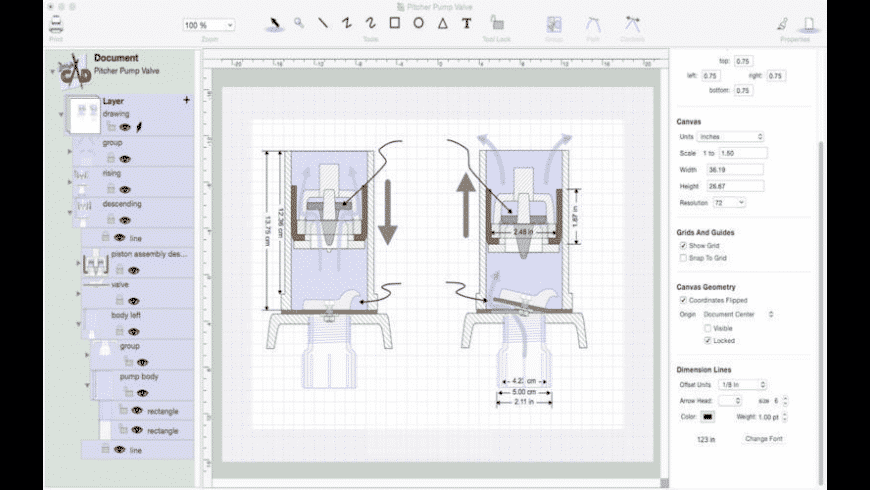“I use a simple software system called DoodleCAD. It takes me about 5 minutes to do each one. The resulting spot images have a cleaner, more vibrant look than is possible using messy old-fashioned paint and canvas. Meanwhile, I'm testing DoodleCad, and it seems to be okay. Joined Dec 20, 2006 Messages 27,017 Reaction score 806 Points 113 Location Lake Mary.
Doodlecad, Fort Collins, Colorado. DoodleCAD™ is an easy to learn, feature rich and inexpensive bezier drawing, illustration, diagramming and 2D CAD application for Mac OS X. The fact is dots and spots have been around for ages and there’s nothing special about using them in a painting. The ‘Cheeky Smiley’ image below adds a new twist by incorporating an emoticon, the Smiley, but a slightly cheeky one. Dave Summer’s ‘digital paintings’ are produced using DoodleCAD software.
Get your
DoodleCAD User Guide HERE!
Minimum requirement: Mac OS 10.9.
Sample projects available soon.
DoodleCAD FAQs:
Question:
I purchased the full version of DoodleCAD in 2019 but since upgrading to Catalina I cannot restore the purchase.
Answer:
The solution is to delete DoodleCAD completely from your computer, empty the trash, then go to the Apple App Store and download DoodleCAD again.

NOTE: Make sure you login to the App Store with the same username (login) as when you purchased DoodleCAD in the first place.
DoodleCAD
Draw Like a Pro Today! .. and have fun doing it.
DoodleCAD v1.6.20 (released Jan. 1, 2020) for MAC is so simple to use that you can be drawing like a professional in minutes. You can create illustrations for web pages, or copy and paste into popular page layout programs and text editors! The current version includes bug fixes for a smoother experience with the newest Mac OS.
Professionals can benefit from DoodleCAD's drafting tools, ease of use and affordability when doing small CAD projects which include dimensions and angle requirements! Why pay hundreds of dollars for other applications for Mac when you can use DoodleCAD?

iLog Student Driving
Doodlecad For Pc
We are no longer supporting iLog Student Driving and do not have any plans to update the application. We apologize for any inconvenience.
In addition to developing software, we have a passion for backyard veggie gardens, aeroponics and hydroponics! Bcm driver download. We are combining our interests to create TechnoTomato!
Doodle Pad Review
Check back soon for details!
Dots and Spots in Visual Culture
Fresh Start magazine ad, USA, 1966

There is no limit to human creativity when it comes to inventing new art forms. This post discusses the use of Dots and Spots and aims to become a preliminary blog archive on this aspect of visual culture. Other examples can be added over the course of time to produce a more comprehensive review.
The use of dots or spots in visual culture has a long history. In the 1960s dots and spots could be found everywhere in design and advertising. The ad shown above comes from a US magazine of 1966. Wallpaper designs in the 60s often used dots in complex patterns to provide a heady mix of colours and lines.
The use of polka dots has a long history. The example below is from 1920.


Seeing dots or spots or “stars” before the eyes is associated with knocks on the head and other minor traumas that affect the central nervous system. There are also spots, specks, flecks and “cobwebs” that drift aimlessly around in our field of vision which are known as “floaters”. Ordinary eye floaters are quite common and no cause for alarm. Floaters are caused by tiny pieces of the eye’s internal vitreous humor that can break loose within the eye. Spots and floaters are more pronounced when peering at a bright, clear sky or a light computer screen. What we actually see is the shadows of the floating bits and pieces cast onto the retina. Floaters never stay still but move when our eye moves so you can never actually focus on them so it can be a little bit annoying.
Perhaps our fascination with dot patterns stems from the floaters in our eyes that simply never sit still. A wallpaper or table cloth pattern with a regular pattern of dots becomes extra attractive. Artists and designers have used dots in a huge variety of ways. One of the most significant art movements of the late 19th and early 20th centuries was Impressionism and its off-shoot Pointillism. Impressionists used short, thick, stabbing strokes of paint which was often applied impasto.
Georges Seurat's 'Sunday Afternoon on the Island of la Grande Jatte', 1984-6.
Vincent Van Gogh used a pointillist technique in his Self Portrait, 1887. This technique places small, distinct dots of pure, unmixed color in patterns onto the support to form an image. The sense of solidity and form are created by the observer’s own visual system by joining all the dots together to produce a harmonious whole.
One of the best known appliers of the humble dot in contemporary art is Bridget Riley. Although Riley uses lines more than dots, dots have played a role in creating some wonderful shimmering optical effects such as in ‘Fission’ (1966).
'Fission', Bridget Riley, 1963
The use of dots in conceptual art by Damian Hirst has recently received publicity in the media. The fact is dots and spots have been around for ages and there’s nothing special about using them in a painting. The ‘Cheeky Smiley’ image below adds a new twist by incorporating an emoticon, the Smiley, but a slightly cheeky one. Dave Summer’s ‘digital paintings’ are produced using DoodleCAD software. Summer argues that there is little point painting these types of work on canvas which can be messy, time-consuming and expensive. Digital production on a computer is cleaner, faster and more efficient.
Doodlecast
What our fascination with dots and spots will lead to next is anybody’s guess.
